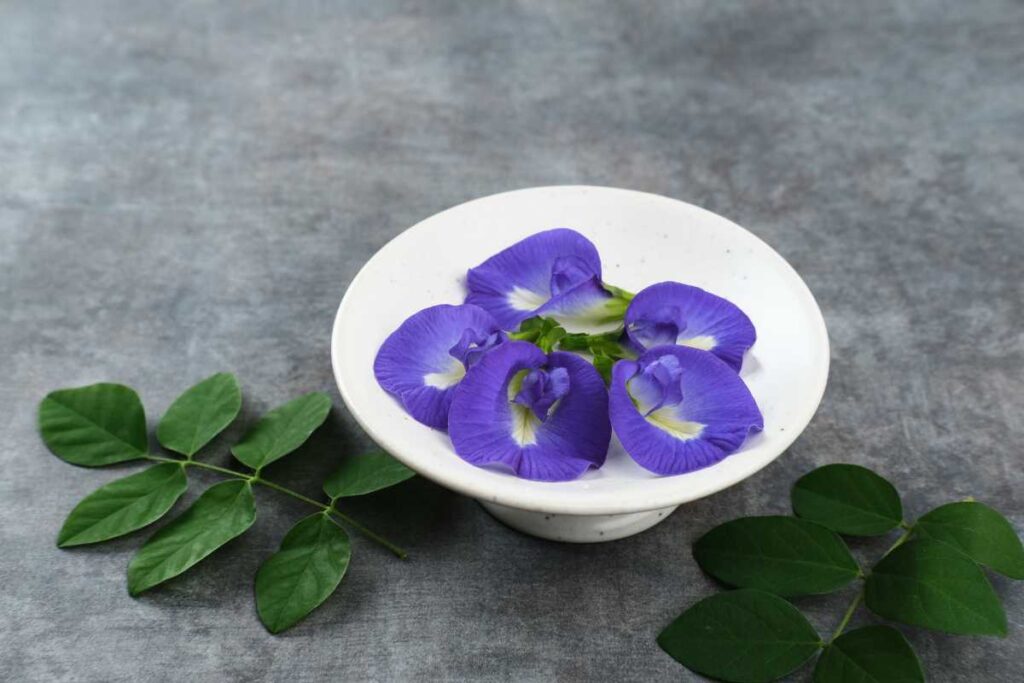8 Health Benefits of Clitoria Ternatea: A Comprehensive Guide

Clitoria ternatea, also known as butterfly pea, blue-pea, or Asian pigeonwings, is a species of flowering plant in the subgenus Clitoria. The name “Clitoria” comes from the Greek word “kleitoris,” which means “little key,” referring to the shape of the flower. This plant has been used for centuries in traditional medicine and cooking due to its various health benefits.
The flowers of Clitoria ternatea are typically blue, but they can also be white or pink. They are commonly used to make tea, food coloring, and natural remedies. In traditional medicine practices such as Ayurveda and Chinese Medicine, Clitoria ternatea is believed to have properties that help improve memory and brain function, reduce stress and anxiety, and promote healthy hair growth.
However, despite its many uses and benefits, Clitoria ternatea crops are often plagued by Meloidogyne incognita – a type of root-knot nematode that causes significant damage to the plants.
The name “ternatea” refers to Ternate Island in Indonesia where this plant was first discovered. The plant is native to Southeast Asia but has since spread throughout other regions such as Africa and South America.
In addition to its medicinal properties, Clitoria ternatea is also used for culinary purposes in many countries worldwide. Its flowers are commonly used as a natural food coloring agent due to their vibrant blue color.
Health Benefits of Consuming Clitoria Ternatea: A Comprehensive Guide
Rich in Antioxidants: Fighting Free Radicals with Clitoria Ternatea
Clitoria ternatea is a plant that is rich in antioxidants, which help fight free radicals and reduce oxidative stress in the body. Oxidative stress occurs when there is an imbalance between the production of free radicals and the body’s ability to counteract their harmful effects. This can lead to cellular damage and contribute to various chronic diseases such as cancer, diabetes, and heart disease.
Consuming clitoria ternatea can provide numerous health benefits due to its high levels of antioxidants. Studies have shown that the flower extract has potent antioxidant activity, which can protect against oxidative damage caused by environmental toxins and other factors. In fact, one study found that clitoria ternatea extract was able to reduce oxidative stress markers in rats.
Improving Cognitive Function: Memory Boost with Clitoria Ternatea
Clitoria ternatea has been found to improve cognitive function and memory in humans. The flower contains compounds known as flavonoids, which have been shown to increase blood flow to the brain. Increased blood flow means more oxygen and nutrients are delivered to brain cells, leading to improved cognitive function.
In one study, participants who consumed clitoria ternatea extract showed significant improvements in memory retention compared to those who did not consume it. Another study found that daily consumption of clitoria ternatea extract for 12 weeks resulted in improvements in attention span, working memory, and information processing speed.
Anti-Inflammatory Properties: Alleviating Pain with Clitoria Ternatea
Clitoria ternatea has anti-inflammatory properties that can help alleviate pain and swelling in the body. Inflammation is a natural response by the immune system when it detects injury or infection; however, chronic inflammation can lead to various health problems such as arthritis, heart disease, and cancer.
Studies have shown that clitoria ternatea extract can reduce inflammation in the body by inhibiting the production of pro-inflammatory cytokines. In one study, rats with induced arthritis showed a reduction in joint swelling and pain after consuming clitoria ternatea extract.
Promoting Healthy Gut Bacteria: Digestive Health with Clitoria Ternatea
Clitoria ternatea has been found to promote healthy gut bacteria and reduce inflammation in the gut. The flower contains prebiotic compounds, which are food sources for beneficial gut bacteria. These bacteria play a crucial role in maintaining digestive health and overall well-being.
In one study, participants who consumed clitoria ternatea extract showed an increase in beneficial gut bacteria such as Lactobacillus and Bifidobacterium. Another study found that clitoria ternatea extract reduced inflammation markers in the colon of rats with induced colitis.
Lowering Blood Sugar Levels: Natural Remedy for Diabetes with Clitoria Ternatea
Regular consumption of clitoria ternatea has been linked to lower blood sugar levels, making it a potential natural remedy for diabetes. Diabetes is a chronic condition characterized by high blood sugar levels due to insulin resistance or insufficient insulin production.
Studies have shown that clitoria ternatea extract can improve glucose metabolism and increase insulin sensitivity. In one study, diabetic rats treated with clitoria ternatea extract showed significant reductions in blood sugar levels compared to untreated rats.
Improving Cardiovascular Health: Cholesterol Reduction with Clitoria Ternatea
The high levels of anthocyanins found in clitoria ternatea have been shown to improve cardiovascular health by reducing cholesterol levels and improving blood vessel function. Anthocyanins are pigments that give plants their vibrant colors and have potent antioxidant properties.
In one study, participants who consumed anthocyanin-rich foods such as clitoria ternatea showed significant reductions in LDL cholesterol levels and improvements in blood vessel function. Another study found that rats fed a high-fat diet and treated with clitoria ternatea extract had reduced total cholesterol and triglyceride levels.
Boosts Brain Function and Relieves Stress and Anxiety
Studies have shown that Clitoria ternatea can provide numerous benefits to the brain. One of the most notable benefits is its ability to boost brain function and improve memory. In one study, participants who consumed Clitoria ternatea extract experienced significant improvements in their cognitive abilities compared to those who did not consume it. The plant’s extracts have been found to reduce stress and anxiety in both animals and humans. This makes it an excellent natural remedy for individuals struggling with these conditions.
Research has suggested that consuming Clitoria ternatea can reduce the activity of genes related to cognitive decline. This means that regular consumption of this plant may help prevent or slow down age-related decline in cognitive abilities. Advances in science have also revealed that the compounds found in Clitoria ternatea can promote the growth of new brain cells, which is essential for maintaining good mental health.
Studies on rats have demonstrated that consuming Clitoria ternatea can enhance the production of serotonin, a neurotransmitter that plays a crucial role in regulating mood. Serotonin deficiency has been linked to depression, anxiety, and other mental health disorders. Therefore, regular consumption of this plant may help alleviate symptoms associated with these conditions.
The application of Clitoria ternatea in eco-biology has shown promising results in strengthening the bond between plants and their environment. The plant’s roots contain nitrogen-fixing bacteria that help enrich soil quality by converting atmospheric nitrogen into a form usable by plants. This process helps increase crop yield while reducing fertilizer use, making it an environmentally friendly solution for farmers.
Rich in Antioxidants and Anti-Inflammatory Properties
Antioxidants are essential compounds that protect the body from damage caused by harmful molecules called free radicals. Clitoria ternatea, commonly known as butterfly pea, is a plant that is rich in antioxidants, particularly flavonols and anthocyanins. These antioxidants have been linked to a range of health benefits.
Studies have shown that Clitoria ternatea leaf extracts have high levels of anthocyanins, with some new anthocyanins being discovered in recent years. Anthocyanins are pigments responsible for the blue color of the plant’s flowers. They are potent antioxidants that help fight oxidative stress and inflammation in the body. In one study, researchers found that Clitoria ternatea extract significantly reduced oxidative stress markers in rats with induced liver damage.
Flavonol glycosides are also present in Clitoria ternatea, which contribute to its antioxidant properties. Flavonols are a type of flavonoid compound found in many fruits and vegetables, including berries, apples, onions, and broccoli. They have been shown to reduce inflammation and improve heart health by decreasing blood pressure and improving blood flow.
In Ayurvedic medicine, Clitoria ternatea has been used as an analgesic and for its pharmacological activities, which may be due in part to its antioxidant and anti-inflammatory properties. A study published in the Journal of Ethnopharmacology showed that ethanolic extract of Clitoria ternatea exhibited significant anti-inflammatory activity against carrageenan-induced paw edema in rats.
The plant has also been used as a natural food colorant, particularly in tea and other beverages. The blue color from the petals can turn green tea into a vibrant shade of blue or purple when steeped together. Butterfly pea flower tea is popular across Southeast Asia for its unique flavor profile and stunning visual appeal.
Potential Side Effects and Dosage Recommendations
Potential Side Effects: Drug Interactions, Allergic Reactions and Gastrointestinal Discomfort
While Clitoria ternatea is generally considered safe for consumption, there are potential side effects to be aware of. One of the most important factors to consider when taking any supplement or medication is the possibility of drug interactions. It’s always a good idea to consult with a healthcare professional before adding any new supplements to your routine, especially if you’re taking prescription medications.
Another possible side effect is an allergic reaction. Some people may experience symptoms such as hives, itching, or difficulty breathing after consuming Clitoria ternatea. If you have a known allergy to legumes or beans, it’s recommended that you avoid this supplement altogether.
Finally, gastrointestinal discomfort may occur in some individuals who take Clitoria ternatea. This could manifest as bloating, gas, or diarrhea. To minimize the risk of these side effects occurring, it’s important to follow dosage recommendations carefully and start with a lower dose initially.
Dosage Recommendations: Factors Affecting Intake
There are several factors that come into play. Age and weight are two important considerations – children and adults may require different dosages based on their body size and developmental stage.
The intended use of Clitoria ternatea can impact dosage recommendations. For example, someone using this supplement for cognitive enhancement may require a different dose than someone using it for its anti-inflammatory properties.
It’s also worth noting that many studies on Clitoria ternatea have used animal models rather than human subjects. As such, more research is needed to determine optimal dosages for humans specifically.
Subsequent Studies: Signal Peptide and Backbone Cyclization
In recent years, researchers have conducted numerous studies on various aspects of Clitoria ternatea. One area of interest has been the effects of this plant on signal peptide and backbone cyclization. These processes are important for protein synthesis, and may play a role in various physiological functions.
One study published in the journal Biochemistry explored the effects of Clitoria ternatea extract on these processes. The researchers found that certain compounds within the extract were able to enhance both signal peptide processing and backbone cyclization, suggesting potential therapeutic applications for this supplement.
Gilding et al: Pods as Potential Therapeutic Compounds
Another area of research has focused on the pods of Clitoria ternatea specifically. A study conducted by Gilding et al (2015) found that these pods contain potential therapeutic compounds. In particular, they identified several peptides with potential antimicrobial properties.
This research is promising for anyone interested in natural remedies for infections or other health issues caused by bacteria. However, it’s worth noting that more studies are needed to determine how effective these compounds are when consumed orally, and whether they have any negative side effects.
How to Grow and Cultivate Clitoria Ternatea: An Overview
Growing and Cultivating Clitoria Ternatea: An Overview
Growing clitoria ternatea can be an enjoyable and rewarding experience for gardeners of all skill levels. This beautiful flowering plant, also known as butterfly pea or blue pea, is native to Southeast Asia but has become popular worldwide due to its stunning blue flowers and numerous health benefits. In this section, we will discuss the different methods of growing and cultivating clitoria ternatea.
Propagating Through Hairy Root Cultures
Hairy root cultures are a unique method of propagating plants that involves the use of a specific bacteria to induce the growth of roots in a tissue culture. This method has been successfully used for clitoria ternatea propagation, allowing growers to produce large quantities of plants in a short amount of time.
To start hairy root cultures, sterilized clitoria ternatea seeds are germinated on agar plates containing nutrients and plant hormones. Once the seedlings reach a certain size, they are transferred to liquid media containing the bacteria Agrobacterium rhizogenes. The bacteria infects the plant cells and triggers the growth of new roots from the stem tissue.
Root Culture Propagation
Another method for propagating clitoria ternatea is through root cultures. Pieces of the plant’s roots are placed in a nutrient-rich medium to encourage new growth. This technique is particularly useful when trying to propagate older plants that have stopped producing new shoots or when starting with limited seed stock.
When growing clitoria ternatea using this method, it is important to ensure that you use healthy roots free from any signs of disease or damage. The rooting medium should be well-draining but retain enough moisture for optimal growth.
Care Requirements
Regardless of how you choose to propagate your clitoria ternatea plants, providing proper care is essential for their success. When planting them outdoors or in containers, make sure to choose a location that receives ample sunlight and has well-draining soil. The plant requires regular watering, but care should be taken not to overwater as this can lead to root rot.
Pruning the plant regularly will help promote new growth and prevent it from becoming too leggy. Applying a balanced fertilizer every two weeks during the growing season can help ensure optimal growth and blooming.
Where to Find Clitoria Ternatea and How to Obtain Seeds
Clitoria ternatea, also known as butterfly pea or blue pea, is a beautiful plant with vibrant blue flowers that are commonly used in herbal teas and traditional medicine. If you’re interested in growing this plant at home, here’s what you need to know about where to find clitoria ternatea and how to obtain seeds.
Finding Clitoria Ternatea
Clitoria ternatea is native to tropical regions of Asia, Africa, and South America. In these areas, it can be found growing wild along roadsides and in fields. However, the plant is also widely cultivated as an ornamental plant due to its stunning blue flowers. You may be able to find clitoria ternatea plants for sale at local nurseries or garden centers.
Obtaining Seeds
If you’re unable to find clitoria ternatea plants locally, you can also purchase seeds online from reputable seed stores. When purchasing seeds online, it’s important to ensure that they are from a reputable source so that you can be sure of their quality and viability.
Once you have obtained your clitoria ternatea seeds, it’s time to start thinking about how best to grow them.
Growing Clitoria Ternatea from Seeds
To successfully grow clitoria ternatea from seeds, there are a few things you’ll need to keep in mind:
- Warm Temperatures: Clitoria ternatea seeds require warm temperatures (around 70-80°F) in order to germinate successfully. If you live in a cooler climate or are starting your seeds indoors during the winter months, consider using a seedling heat mat or placing your pots near a heat source such as a radiator or heating vent.
- Moist Soil: Keep the soil moist but not waterlogged until the seedlings emerge. After that, water the plants when the top inch of soil feels dry to the touch.
- Good Drainage: Clitoria ternatea prefers well-draining soil. If your soil is heavy or clay-like, consider adding perlite or vermiculite to improve drainage.
- Full Sun: Clitoria ternatea thrives in full sun but can also tolerate partial shade.
- Propagation: Once established, clitoria ternatea is relatively easy to care for and can be propagated through cuttings or division.
Growing Conditions and Soil Requirements for Clitoria Ternatea
Well-Draining Soil is Crucial for Clitoria Ternatea Growth
Clitoria ternatea, also known as butterfly pea, is a beautiful flowering plant that requires specific growing conditions to thrive. One of the most important factors to consider when growing this plant is the soil type and quality. Clitoria ternatea prefers well-draining soil to prevent waterlogging and root rot. When planting this species, it’s essential to ensure that the soil has good drainage properties. Sandy loam or sandy clay soils are ideal for cultivating this plant.
The Ideal pH Range for Clitoria Ternatea Soil
The pH level of the soil used to grow Clitoria ternatea should be within a range of 5.0 to 7.5, which is slightly acidic to neutral. The optimal pH range ensures that the nutrients in the soil are available to the plant in an easily accessible form. If the pH level falls below 5 or above 7.5, it can affect nutrient availability and uptake by the roots, leading to stunted growth or even death of the plant.
Sun Exposure and Shade Requirements
Clitoria ternatea thrives in full sun exposure but can tolerate partial shade in hot climates. In areas with extreme heat or intense sunlight, providing some shade can help protect against leaf scorching and dehydration stress on plants. However, too much shade can reduce flower production and overall growth rate.
Soil Types That Support Clitoria Ternatea Growth
Clitoria ternatea can grow in a variety of soil types, including sandy, loamy, and clay soils; however, they must have good drainage properties mentioned earlier. Loamy soils are ideal because they contain a mixture of sand, silt and clay particles that provide adequate drainage while retaining enough moisture for healthy growth.
Benefits of Adding Organic Matter
Adding organic matter such as compost or well-rotted manure to the soil can improve its fertility and moisture retention capacity, which can benefit the growth of Clitoria ternatea. Organic matter enhances soil structure, increases nutrient availability, and promotes beneficial microbial activity in the soil. A healthy soil ecosystem supports plant health and helps prevent disease.
Tips for Propagation, Harvesting, and Storage of Clitoria Ternatea
Seed Germination: Soaking and Planting
Clitoria ternatea, also known as butterfly pea or blue pea, is a beautiful flowering plant that has gained popularity in recent years due to its various health benefits. If you’re interested in growing this plant, one of the first things you need to know is how to propagate it from seed. Seed germination is best achieved by soaking the seeds in water for 24 hours before planting them in well-draining soil.
To start, place the seeds in a bowl of room temperature water and let them soak for a day. This will help soften the hard outer shell and allow moisture to penetrate the seed. After 24 hours, drain off any excess water and plant the seeds about an inch deep into moist soil. Keep the soil evenly moist but not waterlogged, and provide bright indirect light until the seedlings emerge.
Managing Butterfly Pea Pastures: Regular Pruning
Once your butterfly pea plants have grown to maturity, they will require some maintenance to keep them healthy and looking their best. Managing butterfly pea pastures involves regular pruning to promote bushier growth and prevent leggy stems.
To prune your plants, use clean sharp scissors or pruning shears to snip off any dead or damaged foliage. Cut back any long stems that are getting too tall or lanky, making sure to cut just above a leaf node where new growth can emerge. You can also pinch back the tips of young plants early on to encourage branching and fuller growth.
Propagation Through Stem Cuttings
In addition to seed propagation, clitoria ternatea can also be propagated through stem cuttings. This method is especially useful if you want to clone a particular variety or if your original plant has become too large or unwieldy.
To take stem cuttings, select healthy disease-free branches from your existing plant that are at least six inches long with several sets of leaves attached. Remove the lower leaves and dip the cut end into rooting hormone powder before planting in moist soil. Keep the soil damp and provide bright indirect light until roots have formed.
Harvesting and Storing Clitoria Ternatea
Finally, if you’re growing clitoria ternatea for its beautiful flowers, you’ll want to know how to harvest and store them properly. Harvesting should be done in the morning when the flowers are fully open and at their most vibrant color. Cut the stems just below where a set of leaves attaches, taking care not to damage any buds or new growth.
To store clitoria ternatea flowers, they can be dried in a cool, dark place by hanging them upside down or laying them out on a screen or tray. Once fully dry, remove any stems or leaves and store the flowers in an airtight container for up to a year. You can use these dried flowers for tea blends, natural dyeing projects, or as a decorative element in potpourri or sachets.
The Potential of Clitoria Ternatea as a Beneficial Plant
In conclusion, it is evident that Clitoria Ternatea has numerous health benefits and can be grown easily. This plant has been used for centuries in traditional medicine to treat various ailments. It contains compounds that boost brain function, relieve stress and anxiety, and possesses antioxidant and anti-inflammatory properties.
However, it is essential to note that like any other herb or supplement, Clitoria Ternatea may have potential side effects if consumed in large quantities. Therefore, it is crucial to follow the recommended dosage guidelines.
Growing Clitoria Ternatea is relatively easy as it requires minimal care. It can thrive in different soil types and growing conditions; thus, anyone can cultivate this plant regardless of their location.




